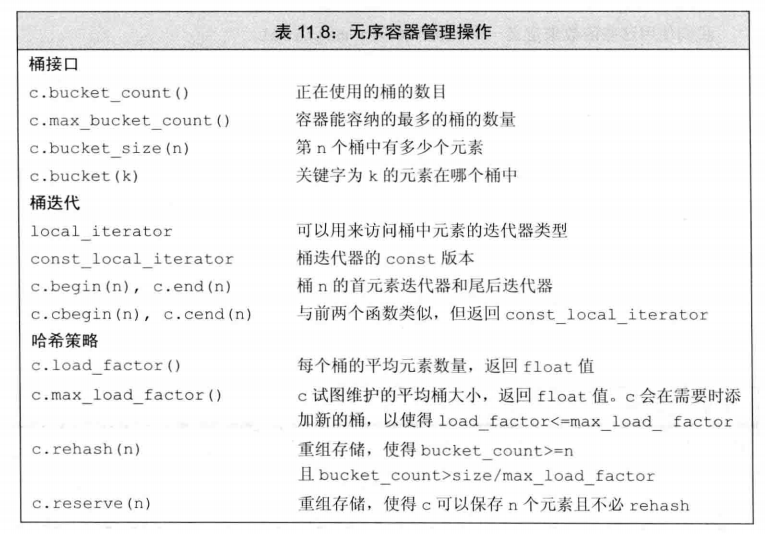无序容器
无序列表不使用比较运算符来组织元素,而是使用哈希函数和关键字类型的==运算符。在关键字没有明显序关系时,使用此类容器会减免维护元素的序代价。
无序容器也有允许重复关键字的版本。使用无序容器替换有序容器会产生的区别在于:输出时的结果顺序会不同。
string word;
while (std::cin >> word) {
++word_count[word]; // 提取并递增word的计数器
}
for (const auto& w : word_count) { // 对map中的每个元素
// 打印元素
cout << w.first << " occurs " << w.second << ((w.second > 1) ? " times" : " time") << endl;
}
管理桶
无序容器在存储上组织为一组桶,每个桶保存零个或多个元素。无序容器使用哈希函数将元素映射到桶。

关键字类型的要求
默认情况下,无序容器使用关键字类型的==运算符来比较元素,它们还使用一个hash<key_type>类型的对象来生成每个元素的哈希值。
内置类型,string和智能指针类型包含hash模板,因此可以用于定义无序容器。其他类型需提供自己的hash模板。
自定义类类型作为unordered_multiset,需提供函数代替==运算符和哈希值计算函数。1:
class Student {
public:
Student(string n = "", int a = 0) :name(n), age(a) {}
public:
string name;
int age;
};
size_t hasher(const Student& stu) {
return std::hash<string>()(stu.name);
}
bool eqOp(const Student& stu1, const Student& stu2) {
return stu1.name == stu2.name;
}
int main()
{
unordered_multiset<Student, decltype(hasher)*, decltype(eqOp)*> students(42, hasher, eqOp);
students.insert({ "aaa", 1});
}
写法2:
struct Student {
string name;
int id;
// 重载比较操作符
bool operator==(const Student& other) const {
return name == other.name;
}
};
// 为Student类型提供哈希函数特化
namespace std {
template <>
struct hash<Student> {
size_t operator()(const Student& stu) const {
return hash<string>()(stu.name);
}
};
}
int main() {
unordered_multiset<Student> students; // 无需显式指定哈希和相等操作函数
students.insert({ "aaa", 1 });
for (const auto& stu : students) {
cout << stu.name << " " << stu.id << endl;
}
return 0;
}
文章评论